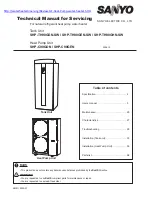
Page 4
5.
The use of resin cleaners in an unvented enclosure is not recommended.
6.
INLET/OUTLET PLUMBING:
Connect to supply line downstream of outdoor spigots.
Install an inlet shutoff valve and plumb to the unit’s bypass valve inlet located at the
right rear as you face the unit. There are a variety of installation fittings available. They
are listed under
Installation Fitting Assemblies.
When assembling the installation
fitting package (Inlet and Outlet), connect the fitting to the plumbing system first and
then attach the nut, slit ring and o-ring. Heat from soldering or solvent cements may
damage the nut, split ring or o-ring. Solder joints should be cool and solvent cements
should be set before installing the nut, split ring and o-ring. Avoid getting solder flux,
primer and solvent cement on any part of the o-rings, split rings, bypass valve or control
valve. If the building’s electrical system is grounded to the plumbing, install a copper
grounding strap from the inlet to the outlet pipe.
Plumbing must be done in
accordance with all applicable local codes.
7.
DRAIN LINE:
First, be sure that the drain can handle the backwash rate of the system.
Solder joints near the drain must be done prior to connecting the drain line flow control
fitting. Leave at least 6” between the drain line flow control fittings and solder joints.
Failure to do this could cause interior damage to the flow control. Install a 1/2” I.D.
flexible plastic tube to the Drain Line Assembly or discard the tubing nut and use the ¾”
NPT fitting for rigid pipe. If the backwash rate is greater than 7 gpm, use a ¾” drain line.
Where the drain line is elevated but empties into a drain below the level of the control
valve, form a 7” loop at the discharge end of the line so that the bottom of the loop is
level with the drain connection on the control valve. This will provide an adequate anti-
siphon trap. Where the drain empties into an overhead sewer line, a sink-type trap must
be used. Run drain tube to its discharge point in accordance with plumbing codes. Pay
special attention to codes for air gaps and anti-siphon devices
8.
BRINE TANK CONNECTION:
Install a 3/8” O.D. polyethylene tube from the Refill
Elbow to the Brine Valve in the brine tank.
9. OVERLOW LINE CONNECTION:
AN OVERFLOW DRAIN LINE RECOMMENDED WHERE A BRINE OVERFLOW COULD
DAMAGE FURNISHINGS OR THE BUILDING STRUCTURE.
Your softener may be equipped
with a brine tank safety float which greatly reduces the
chance of an accidental brine overflow. In the event of a malfunction, however, an
OVERFLOW LINE CONNECTION will direct the “overflow” to the drain instead of spilling
on the floor where it could cause considerable damage. This fitting should be on the side
of the cabinet or the brine tank. To connect overflow fitting, locate hole in side of brine
tank. Insert overflow fitting into tank and tighten with plastic thumb nut and gasket from
the inside. Attach a length of 1/2” I.D. tubing (not supplied) to fitting and run to drain.
Do not elevate overflow line higher than 3” below bottom of overflow fitting. Do not “tie”
this tube into the drain line of the control valve. Overflow line must be a direct, separate
line from overflow fitting to drain, sewer, or tub. Allow an air gap as per the drain line
instructions.
IMPORTANT: Never insert a drain line directly into a drain, sewer line, or trap.
Always allow an air gap between the drain line and the wastewater to prevent the
possibility of sewage being back-siphoned into the conditioner.
10.
SERIAL NUMBER:
Record the serial number on the installer’s and customer’s records.
Bypass Valve
The bypass valve is typically used to isolate the control valve from the plumbing system’s
water pressure in order to perform control valve repairs or maintenance. The WS1 bypass
Содержание CHLOR-A-SOFT
Страница 6: ...Page 6 ...
Страница 7: ...Page 7 ...
Страница 14: ...Page 14 Drawings and Part Numbers ...





































